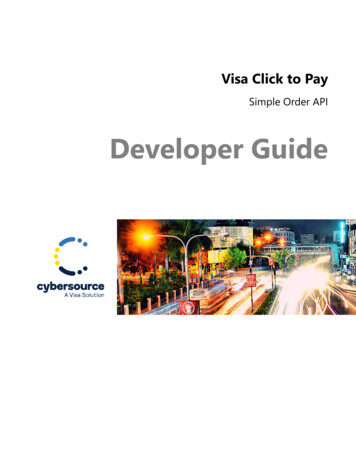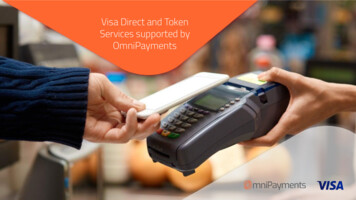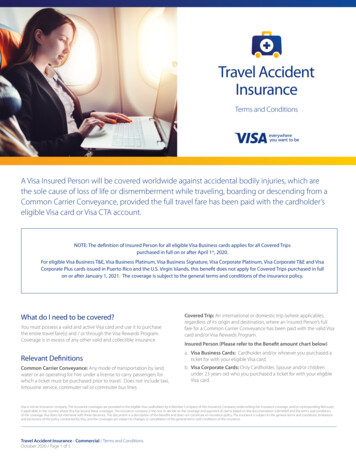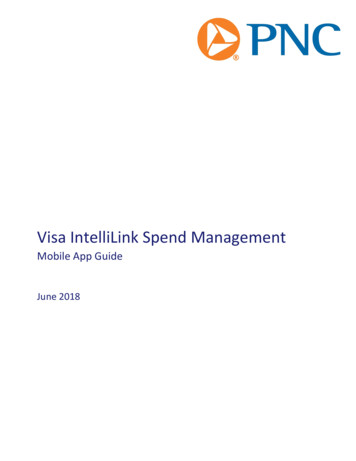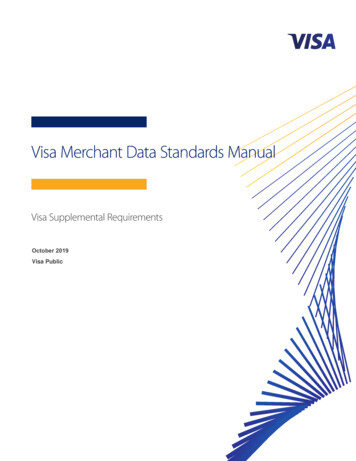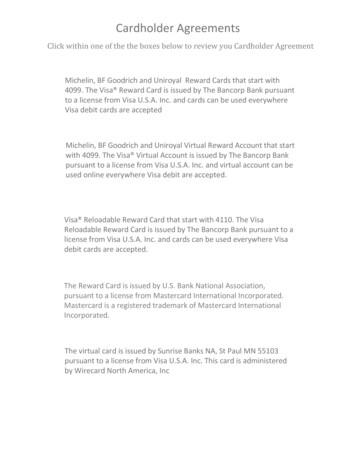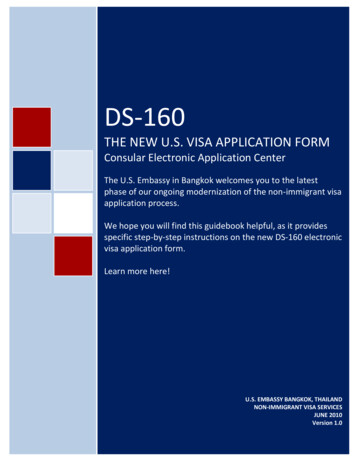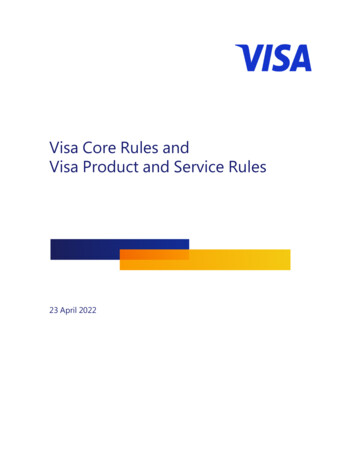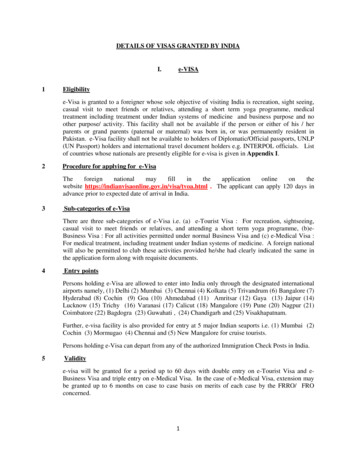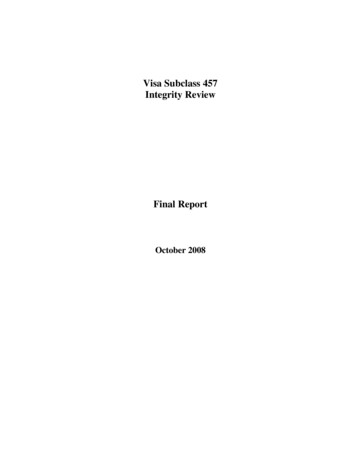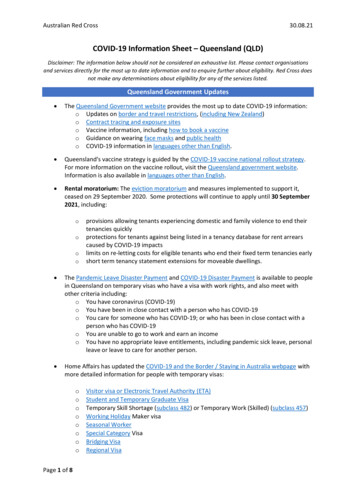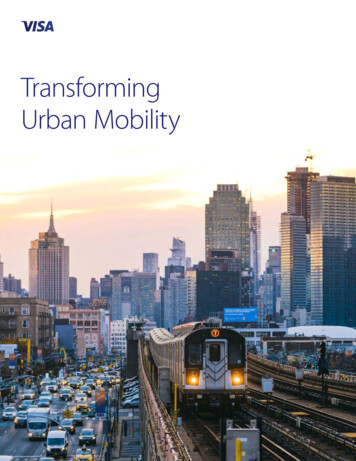
Transcription
VISATransformingUrban Mobility
Transforming Urban MobilityForewordby Nick MackieVice President and Global Head of Urban Mobility, VisaIt perhaps goes without saying that our cities face growing challenges. Withincreasing urbanization, the populations of our cities continue to rise, intensifyingpressure on infrastructure and services.Increasing urbanization is intrinsically connected to urban mobility, enablingpeople to get around in our cities for work, leisure, and education. As the backboneof a city, urban mobility strives to deliver all three pillars of sustainability: our people,our economy, and our environment.We recognize cities that strive to be more inclusive, more connected, moreresilient, and we actively support them in delivering these outcomes. We createvalue by partnering with like-minded cities around the planet to share ourknowledge and expertise, facilitate ecosystem-wide standardization and deliverworld-class services that help achieve shared goals and outcomes—includingimproving life in our cities.Visa has spent the last 15 years working to help simplify and streamline the processof modernizing fare collection systems across all forms of urban mobility, fromtraditional publicly-owned road and rail mass transportation, to privately-runmicro-mobility options such as bike and scooter sharing.Our eforts are having an impact on global urban mobility: We are actively involved in more than 500 urban mobility projects around the globe We have helped public and private transportation operators (PTOs) lower theirticketing overhead, while boosting ridership and improving passenger experiences We are continually utilizing our global network and capabilities to transformthe way people get from A to B, improving connections between peopleenterprises, and governmentsAnd when it comes to payments innovation, over a third of all Visa transactionsglobally are contactless. We have issued over 1 billion tokens to enable securemobile payments with contactless or in-app. These new ways to pay havefundamentally changed the way we pay for goods and services, and their synergywith urban mobility could not be clearer.2
Transforming Urban MobilityVisa’s value proposition in urban mobility stems fromthree core pillars: Products & servicesAt the heart of our capabilities is VisaNet, the world's leader in digital paymentswhich is helping to digitize economies everywhere, creating value beyond thetransaction.Ecosystem leadershipInterfacing with VisaNet, we have defned a set of highly fexible frameworksoptimized for urban mobility operators in alignment with their needs and vision.These frameworks set out our stringent standards and requirements and aresupported by a Visa Ready for Transit program that has primed 150 technologypartners to fully meet them.Global expertiseOur teams around the world have accumulated vast knowledge and experience inurban mobility and have become instrumental in facilitating the delivery of manygame-changing projects. Our custom-designed, globally standardized and scaleableGlobal Delivery Framework helps ensure all projects are setup and run in a way thatdelivers consistent outcomes and value. At the point of launch of new services, wecan take advantage of the Visa brand—named as the ffth most valuable brand inthe world—and network, to encourage uptake and accelerate usage.1Products & ServicesEcosystem LeadershipGlobal ExpertisePayments ProcessingEMV Contactless TravelSpecialized AdvisoryLoyalty, Analytics and InnovationApp-based TicketingTrusted BrandPay-In-Advance SolutionsVisa Ready for TransitGlobal Delivery FrameworkIf you are involved in an urban mobility project or wish to start one, this documentprovides an overview of the key role Visa plays in this feld and how and why wehave developed world-class capabilities to help you succeed.To learn more about Visa’s Global Urban Mobility solutions and how we can help,visit: visa.com/urbanmobilityVISA3
Transforming Urban MobilityExplosive growthIn countries around the world there has been an unprecedented movement ofpeople to urban environments. Today, nearly 54% of people worldwide live incities, up from 30% in 1950.2 With an estimated three million people moving tocities every week,3 the global urban population is expected to reach 68% by 2050.4While COVID-19 may impact these projections, cities will remain vital centers ofcommerce and population.With tremendous growth comes opportunities to mitigate the efects of pollution,congestion, fnancial barriers for underbanked and unbanked, and the pressure onaging infrastructure.Energy use and pollutionStudies show that cities presently consume 78% of the world’s energy and producebetween 60-75% of the world’s greenhouse gas emissions.5 Not surprisingly, themajor contributor is transportation—with passenger vehicles accounting for 70%of emissions and 50% of urban air pollution. On the current trajectory, greenhousegas emissions from transportation are on track to double by 2050.6CongestionCongestion presents a related issue, as many of the world’s cities were simply notdesigned to handle the present volume of vehicular trafc. In fact, research showsthat 46% of commuters to urban centers have seen their commute times increaseover the past fve years.7Congestion results in loss of time and money. In 2019: U.K. drivers lost a total of 5.2B and an average of 115 hours per commuter8 U.S. drivers lost a total of 88B and an average of 99 hours per commuter9Financial barriersUnderbanked and unbanked individuals often struggle with the costs of using publictransport and therefore may lack access to a network that is needed for economicopportunity. This lack of access can contribute to further disenfranchisement andcan restrict overall city health and growth.Ensuring transit services meet the needs of residents and visitors alike is a goal forall cities seeking to optimize their networks and improve overall urban health.4Cities by the Numbers68%City dwellers likely tomake up 68% of world’spopulation by 205078%Consume 78% ofworld’s energy60-75%Produce 60 75% ofworld’s greenhousegas emissions
TransformingUrban Mobilityrming Urban MobilityAging infrastructureAs metropolitan populations grow, it’s important for both prosperityand quality of life that cities improve the efciency and efcacy oftheir infrastructure, and that they ensure solutions implemented toaccess their services are frictionless and future proof. Particularly inlight of the recent pandemic, where restrictions imposed to safeguardthe well-being of our residents, signifcantly reduced the use ofpublic transportation and severely impacted the fnancial position oftransport operators around the world. An investment in infrastructureis crucial to drive efciencies in the short - as well as the long-term.One of the most powerful means ofreducing these harmful consequencesand increasing quality of living is providinggreater access to and hence increasinguse of public transportation systems.Moving forwardThe key to success for cities is the ability to move people and goodsquickly and easily, every day. Making signifcant improvements topublic and private transportation systems will require cooperationfrom a wide range of entities, from think tanks and public authoritiesto private corporations, large and small. This is why Visa is developingtechnology at a global scale and forging partnerships capable ofaddressing these challenges and helping individuals and cities thrive.VISA5
Transforming Urban MobilityVisa Urban MobilityVisa is the world’s largest payment network, with over 3.6 billion cards and more than 11.6 trillion dollars in annual volume transacted in200 countries. Our corporate mission is to connect the world through our innovative and highly-secure network, so that individuals,businesses, and economies may thrive.In urban mobility, Visa is committed to helping cities create efcient, inclusive, and sustainable door-to-door commuting experiencesenabled by simple, convenient, and secure digital payment solutions: Visa Urban Mobility.A better way: Connected, door-to-door journeysFirst MilePublic Transport-0Bicycle / Scooter. ,. Walk HomeCar / Taxi / Car-shareCJ- 0Bicycle / Scooter Trolly--·-·l I ,WorkWalkl I Stationor stopLast MileStationor stopBusLeisureCar / Taxi / Car-shareEducationParking / TollsMetro / Rail / TramParking / TollsPlanning and completing a door-to-door journeyBefore traveling:Plan journeyObtain authorizationto travelDuring traveling:Check progressReceive offersAfter traveling:IncentivesNext time, try Visa is actively working with cities, urban planners, transportation authorities, operators, and solution providers to reimagine the urbantravel experience with a focus on inclusive, sustainable, interconnected, multi-modal transportation.By combining traditional and emerging mobility modalities that are delivered by both public and private operators, these visionariesare creating transportation networks that are efcient, accessible and resilient. These networks also deliver a more open and seamlesscustomer experience that is largely enabled by secure, frictionless fare payment and collection systems—the kind provided by Visa’sUrban Mobility solutions.More connected and convenient payment options encourage ridership, making cities more livable and sustainable and paving the wayfor enjoyable and efcient door-to-door journeys where people get to be where they need to be in a minimum amount of time.V ISA6
Transforming Urban MobilityVisa’s urban mobilityvalue propositionVisa ofers a wide range of urban mobilityproducts, services, and frameworks that weredeveloped with deep technical know-howand years of experience. Our global expertiseprovides reliability as a trusted partner inthe urban mobility arena and the creation ofinclusive, secure, seamless, and ultra-efcienttravel experiences.Visa has multiple solutions to support a fast,easy and secure commuter experience:Cybersource Transit SolutionsPay-in-Advance SolutionsReimbursements(Visa Digital Ticket, Visa Private Label,Visa Prepaid)(Visa Direct)Visa’s products and servicesVisa ofers developers access to a range ofVisa services for building and deploying newexperiences, including gateway, data andinsights, tokenization, risk management, fareprocessing and calculation, debt recovery,and other capabilities.Cybersource for TransitVisa’s Cybersource is a globalpayment management platformthat enables urban mobilityoperators, acquirers, and solution providers torapidly deploy a reliable, scalable, and securedigital and contactless ofering. Unlike manyprocessors, Cybersource supports the Mobility& Transport Transaction framework (more onMTT on the next page), thereby providingfexibility and avoiding unnecessary issuerdeclines. One connection to Cybersourceprovides access to 130 acquirers worldwide,including VPC (Visa Platform Connect),a compelling ofering to facilitate fastdeployment, plus a suite of risk managementand value-added services across the varioussales channels.Data and AnalyticsActionable business insights,the latest economic trends, andproven data driven solutions thatcan help you grow your business are availablethrough Visa Analytics Platform. Visa AnalyticsPlatform ofers fast and secure access toanonymized data and produces real resultsin the areas of core business and emergingtopics by helping you reduce fraud, improveefciencies, and much more.7LoyaltyPartnerships(Visa Ready for Transit)(e.g. Visa CommerceNetwork)UrbanMobilityVisa SecureAccess ModuleAcceptance(e.g. Mass TransitTransaction - MTT)(Secure contactless payments)Data & AnalyticsLoyaltyCard-linked ofers, rewards,redemption and loyalty programopportunities can be ofered viaVisa Commerce Network, Visa Loyalty, andrelated solutions that can increase customerengagement and perceived value of theoverall travel experience.Pay-in-Advance SolutionsVisa ofers a suite of Pay-inAdvance travel solutions thatseamlessly complement contactless pay-asyou-go (PAYG) travel. These solutions helpaddress customers who do not have or prefernot to use EMV Contactless cards and supportthe complexities of passes or season tickets.Pay-in-Advance solutions include the following:Visa Digital Ticket: Contactless technologyapplied to tickets or Store Valued Account(SVA) travel-cards that are purchased andloaded online and provisioned into themobile wallet of a smartphone.Visa Prepaid: A suite of digital and physicalSVA products that can be pre-funded from avariety of sources and available to everyone.Visa Private Label: Issuance and processingservices for non-Visa branded cards that areavailable to everyone but are accepted inspecifc locations.ReimbursementsOfer fast, convenient and secureticket refunds enabled by VisaDirect. Visa Direct is a capabilitythat allows real-time funds delivery directly tofnancial accounts using card credentials. WithVisa Direct, you can reach 200 countries andterritories and facilitate domestic and crossborder payments in over 160 currencies, withbillions of connected endpoints across cardsand accounts, including 3 billion Visa cardsand 2 billion bank accounts.Visa Secure AccessModule (VSAM)Visa SAM makes it easyfor transportation organizations andoperators to ofer riders the ability to tapto pay with a contactless card, phone orwearable device, without the expense andtechnical requirements of replacing currentturnstiles or terminal hardware. Rather thaninstalling brand new turnstiles or hardware,transportation operators can install the VisaSAM software plug-in, built on secure EMVContactless technology, directly into existingsystems. This can signifcantly decrease costand implementation timing.VISA
Transforming Urban MobilityEcosystem leadershipAs a global leader in payments, Visa is well-suited to help navigate the complexecosystem of technology suppliers and partners. Providing expertise forimplementation at a global scale, Visa can help accelerate time to market,thereby maximizing outcomes for all parties. The frameworks below have beendesigned to create inclusive, seamless and ultra-efcient experiences, for thecustomer and the operator:Mobility & TransportTransaction: Interoperablepayment solution in anopen acceptance modelEMV Contactless travel: Pay-as-you-go (PAYG) based on EMV Contactless and Visa’sMTT model are gaining signifcant traction and merit strong consideration by transportoperators seeking to bring a preferred payment technology to their networks. )})EMV Contactless technology has transformed the way people shop and the waymerchants operate worldwide, creating a streamlined process for everyone. Now,contactless is revolutionizing the way people travel, providing customerswith a fast, secure, and frictionless travel experience.Based on EMV Contactless, PAYG is already available in over 250 locations withhundreds more coming worldwide—due to the wide range of benefts it ofers toconsumers, operators, and cities alike. With contactless PAYG, boarding a bus is aseasy as buying a cofee but even faster less than 500 milliseconds, to be precise.FeaturesIn pursuit of its commitment to transforming urban mobility, Visa has developedtwo fexible urban mobility models that enable the acceptance of EMV Contactlesspayment cards. Both models are designed for fast passenger throughput andefcient and secure automatic fare collection. Known Fare Transaction (KFT): KFT is a simple solution ideal for operatorswho wish to implement EMV Contactless in a single mode of transportationwith a fat or distance-based fare. In this model, the rider taps their Visa EMVContactless card, device or wearable that is linked to the card in order to accessa transport service where the fare charged is always known by the reader.Payment authorization happens in real-time, although deferred authorization isalso possible. Mobility & Transport Transaction (MTT): MTT is a fully-fexible solution suitablefor both single mode and multi-modal mass transportation environments. Visa’sMTT framework is a global standard, enabling operators to ofer a range offexible fares, including: fxed fares; distance- and time-based fares; multi-modalfares; and features like fare capping, concessions, and delay refunds. All whileensuring efcient fare collection and limiting the operator’s risk through sharedliability and debt recovery mechanisms.Contactless-only acceptance0Silvester Prakasam, Senior AdvisorFare System Land Transport Authority of SingaporeVISANo financial transactionat point of tapShared merchant/issuer liabilityDeny list & backoÿce managementBeneÿtstttttt“Visa’s MTT framework provides an elegant solution forthe implementation of EMV Contactless in transit withadded security.”Deferred authorizations@High passenger throughputVersatile, adaptable solutionSuited to complex multi-modaltransit systemsNo purchase requiredDrives down PTOoperating costs8
In this model, the rider taps their Visa EMV Contactless card, device or wearable thatis linked to the card to access or board a transport service. The fnal fare charged isnot always known at the time of travel as the tap data is accumulated and the totalfare amount is calculated and charged by the transport merchant at the end of thetravel period. -,-The MTT model goes beyond providing a fast and convenient experience for therider, as it also provides efcient fare collection for the operator. Intended for multimodal transportation, MTT is paving the way to Mobility as a Service (MaaS).MaaS is a growing sector of apps and services that combine planning and paying fortravel within singular digital experiences.When combined with contactless payments, providers can ofer riders greaterfexibility and convenience while removing the need to plan ahead, pre-purchase, orcarry and keep track of a variety of standalone passes and tickets.Contactless can be seamlessly integrated into existing and future MaaS solutionswith nearly unlimited possibilities for rich digital solutions for consumers. App Based ticketing (also known as Stored Credentials Transaction Framework):App-based payments ofer a common and convenient way to pay. A customer simplyprovides their Visa payment credentials to pay for a ticket and consents to storing theircredentials for future use. This framework is called Stored Credentials Transaction andcan be deployed to existing and developing mobile apps and websites.Recognizing stored credential transactions allows for greater visibility into transactionrisk, enables robust processing and may result in diferential treatment frome-commerce transactions, with a higher likelihood of issuer approval. Visa hasdefned authorization data values to help identify initial storage and use of storedpayment credentials to facilitate diferentiated processing.Visa Ready for Transit (VRfT) : The proliferation of technology solution providerscan make it challenging to select a partner. Visa’s global Urban Mobility partnerprogram is designed to help. With over 150 partners worldwide, Visa Ready forTransit gives transportation agencies access to an expanded network of technologysolutions and expertise to support upgrades to next generation fare systems,including ticketing and fare collection, back ofce management and consulting.Visa Ready for Transit helps maximize investments and expedite overall time-tomarket by simplifying the process of identifying the right partner for a project andstreamlining testing and implementation. The certifcation process means that VisaReady-certifed solutions meet Visa’s high standards for security and PCI complianceon a global basis and are ready to be deployed to accelerate go-to-market.9 r- .,,. ,,. lff,IeI!
Transforming Urban MobilityGlobal expertiseVisa demonstrates global expertise by bringing our products, services, andecosystem leadership together in order to enable cities and transport agencies totransform their transportation networks.With a recognized and trusted brand as a foundation, we have applied theexpertise that comes from a multidisciplinary team of experts and the learningfrom working with transport operators in over 500 locations to the Visa UrbanMobility Global Delivery Framework.The Visa Urban Mobility Global Delivery Framework is designed to make it easierfor transit operators to quickly deploy EMV Contactless based ticketing. Clearlydelineating the phases of a typical project, from vision to post-implementation, theframework facilitates outlining recommended actions, defning success metrics,and identifying task owners. The framework and associated delivery process haveproven to reduce time to market and increase the efcacy of the payment solution.At Visa, we take a human-centered approach to the design and implementationof payment fows to deliver the best possible passenger experience. By workingwith partners and clients in hundreds of locations around the world we haveaccumulated expertise that we invest into new, forward-looking paymentsframeworks and service capabilities. Together, these empower our ecosystem tomove quickly and efciently.To further magnify and accelerate collaboration and the arrival of improvedtransport experiences, we foster thought leadership globally by bringing expertstogether, in the form of research papers and specialized forums. By organizing andparticipating in conferences, workshops, webinars, and papers—with participantsacross governments, technology partners, fnancial organizations, urban mobilityoperators and authorities—we share the objectives of understanding pain points,identifying solutions, developing knowledge, and contributing to building thefuture of urban mobility.10
Transforming Urban MobilityBenefts of urban mobilitytransformationReliable, secure, open, multi-modal transportation ofers advantages to all partieswithin the urban mobility ecosystem. Benefts to cities, transport operators, andcustomers include:City benefts Digitization transparency: Transparency and accountability are harder toachieve with cash payments because they are anonymous and difcult to trace.Digital payments increase accountability and tracking, lessening the risk ofcorruption and theft Improved security: Shifting from physical tickets and cash enhances security.Digital payments and ticketing can reduce fraud and secondary sales. Visacontactless cards are built on secure EMV Contactless technology, whichis proven to reduce counterfeit fraud.10 In addition, Visa’s advanced globalprocessing network provides secure and reliable payments around the worldand can handle more than 65,000 transaction messages a second Data-driven insights and value-added services: Digital payments allowoperators to capture all journeys and associate them to the same ‘account,’revealing previously hidden insights into ridership trends that can be used tooptimize existing service and introduce targeted new services to better meetdemand, replace costly customer behavior surveys, and improve the accuracy ofrevenue apportionment calculations More liveable cities: Carbon emissions and other forms of pollution can bereduced as cities and transportation operators increase ridership on public andshared transportation. Additionally, traditional ticketing systems contribute togreater carbon emissions Studies have found that when using a contactless payment method versuscash, diesel buses cut emissions by 20%—largely due to shorter dwell times11 Similarly, buses with the most passengers emit the most emissions because oflonger dwell times while picking up passengers12 Embracing innovation in payment systems is a powerful means for cities tocontribute toward the achievement of their climate change and liveability ambitions Inclusivity: Shifting to digital payments for riders presents numerous ways forcities and transportation operators to increase access for those riders in greaterfnancial need. In many cities, such as Sao Paulo or Rio de Janeiro, the bottom20% of earners cannot aford public transportation13 Ofering prepaid Visa cards introduces riders who do not possess a card toprepaid, debit, or credit. This is an opportunity for unbanked and underbankedindividuals to begin participating in the broader fnancial system. Widespreadadoption of digital fnance could increase the annual GDP of all emergingeconomies by 6% over business-as-usual and could provide 1.6B people—more than half of them women—access to life-changing fnancial services1411
Transforming Urban Mobility Operators may more easily adopt more fexible, confgurable, best fareticketing options to reward travel frequency and eliminate upfront discountson weekly or monthly passes Targeted programs may be deployed via partnerships between publictransport operators and governments that subsidize fares for certain riders,providing them with greater access to transportation networks and leavingthem with more disposable incomeTransport operator benefts Cost savings: Digital payments ofer the opportunity to shift sales from higherpriced retail channels, such as ticket vending machines or kiosks. For example,agencies that institute contactless payments are able to reduce fare collectionexpenditures by more than 30%.15 A recent survey found that transport agenciesspend an average of 14.5 cents for every physical dollar collected, comparedto 4.2 cents for every digital dollar.16 Operators may also expand choice forcustomers beyond ticket vending machines and ticket desks Operational efciency: Digital payments can also improve customerthroughput and increase efciency. Removing the friction of payment hassignifcant benefts for the operator, including reducing or removing queues attravel locations such as rail stations, reducing bus dwell times, and increasingefciency of bus services. Studies show that 84% of travelers in major U.S. citieswere frustrated by customers ahead of them taking a long time to purchase aticket and 67% report missing a train due to long ticket lines17 Improved cash fow: Account based ticketing (ABT) systems allow operatorsto manage customers’ right to travel by holding their account informationdirectly—rather than on a card—as is the case with card-centric, closed-loopsystems. ABT systems can settle revenues with operators the same day. Thisincludes those from multi-operator or multi-modal caps or ticketing products,should the operator apportionment process be automated Increased ridership: Improving the customer experience and making it easierfor the customer to use public transport has been shown to boost ridershipand revenues. Research shows that ridership on public transport globally wouldincrease by 27% if transportation was easier to pay for18 Integration: Using proven standards-based technologies, such as EMVContactless and open loop payments, can provide for robust interoperabilityacross the region. It facilitates the integration of diferent operators in the samearea, giving customers a frictionless, safe, and cost-efcient way to get around Risk management: Visa’s MTT framework was designed to minimize potentiallost revenues, with enhancements such as liability sharing and sophisticateddebt recovery methods12“We came to the verysimple realization thatnobody wants to buy aticket and actually, wedon’t want to sell themone, either. If you couldfnd a means of makingthat very simple businessprocess work moreefciently that wouldbe the right thing.”Shashi VermaChief Technology Ofcer,Transport for London
Transforming Urban Mobility“One Metro New York(OMNY) contactlesspayments are designedto save New Yorkerstheir most preciouscommodity: their time.”Patrick J. FoyeChairman & CEO, MTACustomer benefts Increased satisfaction: Providing a seamless, digital way to pay across multiplemodes of transportation is a beneft to riders who have traditionally been forcedto queue to buy a ticket, top up their travel card, or follow a number of steps topre-purchase a ticket online as they navigate their door-to-door journeys With open loop contactless, customers have the choice of loading their cardonto their phone, smartwatch, or wearable, and use it to travel where andwhen they want. There is no need to queue up to buy a ticket, obtain a travelcard, or learn complex fares A study found that nearly half of commuters surveyed in 19 countries fnd itinconvenient to use diferent tickets for diferent modes of travel In the same study, 44% of commuters say they struggle to know howmuch they should pay, and over 40% say they are annoyed by cash-onlyrequirements on transportation19 Privacy: The customer’s ‘account’ travel data is stored in the operator’s systemonly and is anonymized and tokenized to provide operators and customers withpeace of mind when it comes to data sharing and privacy Loyalty: Digital payments enable card-linked ofers with targeted discounts,promotions, and loyalty program rewards to enhance the value of thetransportation experience Targeted notifcations: Enrolled customers can beneft from targetednotifcations, such as changes to their account status, potential disruptions, etc.13
Visa: The preferred way to payAs the world becomes more digital and experiences more seamless, consumersexpect payments to keep pace. Consumers want paying to be fast and convenientand they want the assurance that their data is secured. These expectations arechanging the way people purchase consumer goods and services every dayaround the globe.Over the past fve years, a massive shift has taken place in the payment industry. In2016, contactless accounted for a fraction of the total Visa processed transactionsglobally. Today, that fgure is 38% globally, 76% in Europe, and 81% in CentralEurope, Middle East and Africa.Looking at the exponential growth of the past year in North America, Asia andLatin America, it’s very easy to see how this curve will continue to grow. With EMVContactless, consumers simply tap to pay, with an experience that is not only fasterand easier, but more secure and cost efective. It’s also a gateway to deliverin
Acceptance Visa Secure (e.g. Mass Transit Access Module Transaction - MTT) (Secure contactless payments) Data & Analytics Urban Mobility Cybersource for Transit Visa's Cybersource is a global payment management platform that enables urban mobility operators, acquirers, and solution providers to rapidly deploy a reliable, scalable, and secure
